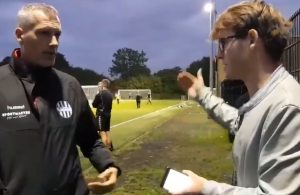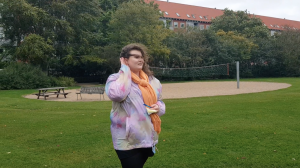RefLevel is a mobile and smartwatch management application designed for football referees that helps the referees before, during and after the match in order to address detailed events happening during the game.
Usually, the referees are using a more traditional approach to gather information using pen and paper to write down the different events happening during the game, for example, yellow and red cards or submissions. That is what the app is trying to reform in a useful and modern way, at the same time making it easier and faster for the person using it to gather all the information.
The problem we are trying to solve is related to the expansion of the app capabilities in order to make it possible for others than the referees to benefit from the information they are gathering during the game.
- How can others than referees benefit from RefLevel (football coaches, sports directors etc)?
Group members
- Camelia Ardei, Entrepreneurial Engineering
- András Pozsonyi, Entrepreneurial Engineering
- Trine Lund, Experiencedesign
- Lisbeth Kjær Tetsche Larsen, Experiencedesign
- Thomas Lindrup Jensen, Interactive Digital Media
- Niklas Missel, Interactive Digital Media
Concept video
We combined three of our solutions into one final solution, for RefLevel to get the most out of our project and the possibility to implement it in to their product.
[su_youtube url=”https://youtu.be/atWHHa9BU00″]
Design process
First week
- Monday – 17th september
The first day was spent discussing the case and preparing questions for the case partner – Rimon from ReflLevel. During this process, we had some initial ideas for the case which we wrote down for later use. After the first meeting, we chose to focus on how others than the referee can benefit from RefLevel (case 1). - Tuesday – 18th september
The second day started off with a discussion about who this case could be relevant for, and which people would be interesting to interview. We planned and prepared questions for the first interview with a football team where we went to talk to the coach and observed a football training session in the afternoon of day two. On this day we also set up an interview with a referee and we found a football game we could go to and observe the next day.

- Wednesday – 19th september
The third day we prepared questions for the three interviews we had set up for the day. Firstly, we interviewed a referee through a Skype call during the day. In the evening we went to a football game to observe the game, but also to interview the referee and one of the coaches.



- Thursday 20th september
The fourth day we mapped out the jobs to be done. We used the method affinity diagram to structure the jobs to be done on post-it notes based on the observations and interviews we conducted and analyzed beforehand.
- Friday – 21st september
On day five we worked on the lower half of the core design framework where the main goal was to come up with five innovation tracks for the case. The different quality criteria were based on the jobs to be done. Through this process, we brainstormed if there were other stakeholders that could be involved, and so we sat up an interview, prepared questions, and made plans to go see a referee talent developer in action. To get an overview of the ideas we’ve had so far we wrote them all on post-it notes with the added purpose of reflection upon who could benefit from these ideas. Again, based on the interviews, observations, and jobs to be done.


- Sunday – 23rd september
The sixth day we held an interview with the referee talent developer at a football game and observed how he acted before, during, and after the game. After the match, he evaluated the referee whom we also talked to, to gather more information.


Second week
- Monday – 24th september
On day one in the second week, we mapped and analysed what we observed during our interview and observations with the talent developer. We also looked at our core design framework with new insights and changed some of the quality criteria that we thought were more valuable. We had a meeting with our case partner to decide on an innovation track. We chose an innovation track focusing on education, evaluation, and usability with a focus on talent developer and referee. From this, we formed the problem definition for our project: How can RefLevel assist in the education of talent referees by facilitating the evaluation with the talent developer in an efficient and user-friendly way? At the end of the day, we mapped out the different pains the referee and talent developer experience before, during, and after the match when they have to work together.

- Tuesday – 25th september
The second day we tried to come up with solutions for the different pains we mapped out the day before. From this, we tried bodystorming some of the ideas by acting out the problem and some of the solutions we came up with. After the bodystorm, we picked five ideas to do video sketching on.
- Wednesday – 26th september
On Wednesday we began to film our five videos based on the scenario we set on Tuesday. We divided into two groups so we were able to deliver the videos to the end of the day. Furthermore some of the videos made on stop motion and for some raw footage we went to the closest soccer field and we shoot our footage and began editing some videos.


- Thursday – 27th september
On the fourth day, we accelerated on the video editing process in order to deliver our sketches for a meeting where we got valuable feedback from a different group. Based on the meeting we ended up with our final solutions to answer the case. We went with a combination of three of our ideas. - Friday – 28th september
The last day of the second week we started out planning for what needed to be done that day.
Concept sketches
#1 Little Helper
Little Helper → An “AI” that takes care of all the formal tasks to make the life easier for both the referee and the talent developer. On the video, you can see before, during and after the match how such a solution would support the referee and the talent developer. In this way, all the documentation and necessary tasks is done by the “AI” little helper.
[su_youtube url=”https://www.youtube.com/watch?v=e8mPo3pHK4o”]
#2 Voice Memos
Voice memos → This idea are meant to help the talent developer during the match, so he can follow why and what the referee is doing during a match. Where the voice memos will also help afterward because it will make the educational use easier and more on point.
[su_youtube url=”https://www.youtube.com/watch?v=ZpEPOvJ3uM0″]
#3 Tablet (before, during and after)
Tablet (before, during and after) → The idea show how the talent developer can use a tablet to take notes and memos during the game, using different field zones so they can discuss all the necessary situations happened during the game and that will lead for better educational use as well.
[su_youtube url=”https://www.youtube.com/watch?v=ehEUtDjpFbk”]
#4 Referee alert
Referee alert → The referee alert is designed to help the referee through different signals via his smartwatch that will tell him what to do. Furthermore, the alert will help with the communication between the linesmen and the referee including the talent developer.
It will also help the referee when he is moving too far away from the ball so the signal warns the referee to keep closer to the action.
[su_youtube url=”https://www.youtube.com/watch?v=60DEgNt8RNI”]
#5 Drone video
Drone video → The concept is about how a drone can follow the referee around the field to give a better point of view, for both the referee and talent developer. The solution would support the lower league referees as well where there isn’t TV broadcast during the game.
After the match, the recorded video can help both the referee and the talent developer to better educational use.
[su_youtube url=”https://www.youtube.com/watch?v=g3YHE42qaLs”]

